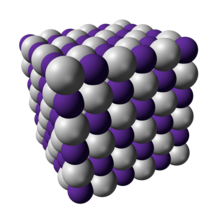 Rubidium cation, Rb+ Hydrogen anion, H− | |
| Names | |
|---|---|
| IUPAC name Rubidium hydride | |
| Other names Rubidium(I) hydride | |
| Identifiers | |
3D model (JSmol) | |
PubChem CID | |
CompTox Dashboard (EPA) | |
| |
| |
| Properties | |
| RbH | |
| Molar mass | 86.476 g/mol |
| Appearance | white cubic crystals |
| Density | 2.60 g/cm3 |
| Melting point | Decomposes at 170°C |
| reacts | |
| Structure | |
| cubic, cF8 | |
| Fm3m, No. 225 | |
| Thermochemistry | |
Std enthalpy of formation (ΔfH⦵298) | −52.3 kJ/mol |
| Related compounds | |
Other anions | Rubidium oxide Rubidium chloride |
Other cations | Lithium hydride Sodium hydride Potassium hydride Caesium hydride |
Except where otherwise noted, data are given for materials in their standard state (at 25 °C [77 °F], 100 kPa). | |
Rubidium hydride is the hydride of rubidium. With the formula RbH, it is classified as an alkali metal hydride. It is a white solid and is insoluble in most solvents. It is synthesized by treating rubidium metal with hydrogen. Rubidium hydride is a powerful superbase and reacts violently with water.